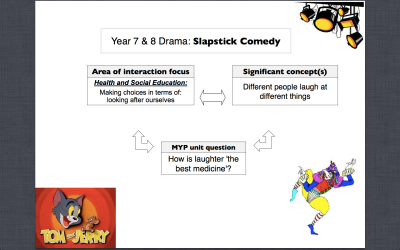The year 7 and 8 classes are studying a unit of work on ‘Slapstick Comedy’. I have posted previously about how we explored the concept of humour in general, and how we defined slapstick comedy. Last week, we kick-started the drama process and began brainstorming for our performances.
Slapstick Comedy: Step two of the drama process!
This week, the ‘theatre companies’ (the fancy name I use for my drama groups) finalised their brainstorms and started writing their scripts and creating their storyboards. The script-writing process was mainly driven by each group’s ‘writer’, while the story-boarding was mainly driven by the group’s ‘director’. The year 7 classes had to do this on their iPads and attach evidence to their group portfolio on Evernote. The year 8 classes (who do not have iPads) were each given a group folder to use as their portfolio for the task. The lesson’s learning objective is to ‘apply the skills, techniques and processes used to create slapstick comedy performances’.
The lesson’s warmup was a game I found on The Drama Notebook called ‘Queen of Hearts’. This game is designed to get students to think about status, as each student is assigned a card from a deck of cards. Each card represents a different character in a medieval royal court, and the higher the card the higher the status of the character. The students then mill about the room, walking and relating to others in character. The class then had a quick debriefing session about the warmup and we related it to the use of status relationships in slapstick comedy to add to the humour, either by overly exaggerating those relationships or challenging them. We also talked about other ways to create character in slapstick comedy, such as creating dominant negative personality traits for each character and designing bizarre over-the-top costumes.
To start the second step of the drama process, which is preparing the script and storyboard, the students used this template which I adapted from a worksheet I stumbled into by accident through a Google search of ‘drama worksheets’ (the Internet is MY BEST FRIEND). The students had to use what we have learned about slapstick comedy so far in their script-writing process (e.g. they must incorporate some slapstick techniques like the trip, slip, collide, double-take, stuck, and lazzi; they must use slow-motion to add dramatic effect to these techniques; and they were also encouraged to use status, personality traits and costumes to add comic potential to their characters). Here are snapshots of one group’s script and storyboard:
Next week, we move into the third step of the drama process, which is ‘to rehearse’. The students will be using a template for blocking and rehearsing, and they will also be using their iPods/iPads/smart-phones to document their rehearsals and reflect on their acting to refine and polish their performances. Stay tuned!








